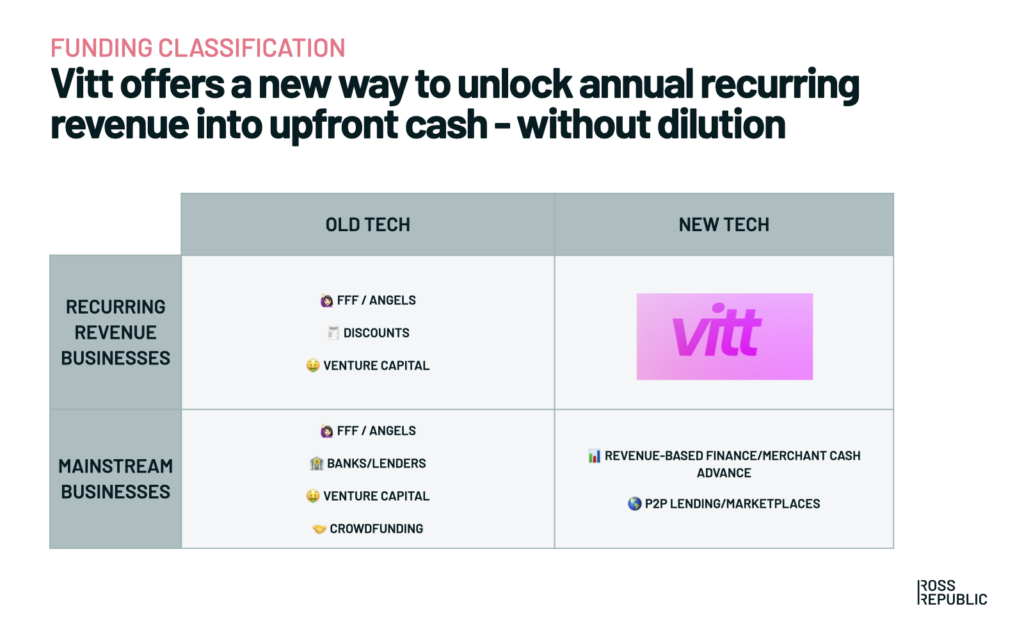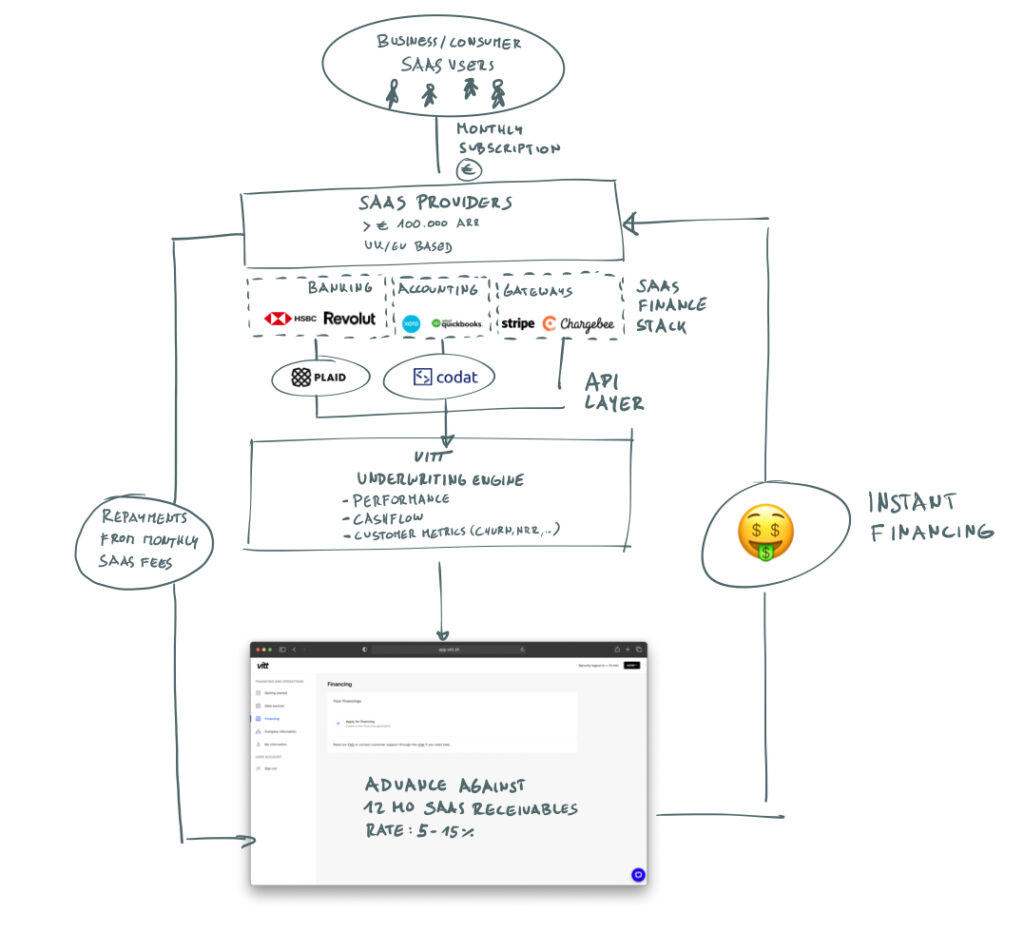Thank you for joining the Ross Republic podcast. In our twenty-seventh episode, host Adrian Klee is joined by Saket Kumar, co-founder and CEO at the fintech Vitt. In this episode, we’ll discuss the growth of recurring revenue business models and how new forms of financing help SaaS founders to grow their business via non-dilutive financing.
RR Podcast #27
Listen now on Spotify / Apple Podcasts / Google Podcasts
Securing a deal with venture capital (VC) investors is generally a strong signal for of success, yet prominent founders, such as Tom Blomfield (GoCardless, Monzo), have lately raised their voices to shed some light on the drawbacks of VC: intense competition between VC firms to deploy capital in faster cycles at ever higher valuations and a process that is rigged against founders: For instance, a well-known VC firm made him wait for hours in the lobby, then the partner appeared to the meeting barefoot and “lit a cigarette and smoked it in his office, windows closed” – you’d think founders could use their time more wisely, but in reality there’s immense pressure to comply in order to get funding. Popular arguments against venture capital funding usually go along the lines of “What’s best for VCs often isn’t best for founders.”, “The fundraising process is broken”, or more sophisticated ones cite the marginal dollar problem, which states that the rapid increase in VC money that is pumped into a start-up to enable blitzscaling diminishes the returns per dollar invested over time.
Early stage start-ups launching disruptive new business models or investing new technologies need investors that embrace the speculative nature of VC investing. It’s often the only way to enable the testing ground of new business ideas that later become large global companies, as in the case of Apple or Amazon. If you’re having extremely high ambitions, crazy ideas and want to take on markets with a sufficiently large addressable market segment, giving away equity for cash is the way to go.
The reality is as always not black and white. VC is an integral part of the global capital structure that has unlocked amazing firms, yet it’s not the right fit for every type of start-up and every maturity stage. While many tech founders opted for VC funding simply due to the lack of suitable alternatives, the industry is now ready for new financing solutions.
Here’s why: As the tech and specifically the software industry has matured, the days of traditional, packaged software licenses are gone. Software-as-a-Service (SaaS) models have become the de facto standard for monetising software, i.e. through recurring subscription fees. SaaS and subscription businesses have become so mature and integrated into modern businesses that their performance can be assessed via industry specific metrics, such as customer acquisition cost (CAC), customer lifetime value (LTV), annual contract value (ACV), return on advertising spend (ROAS), et cetera. These well-established metrics allow to underwrite the opportunity and risk profile of a recurring revenue firm with precision, at least at later maturity stages. Thus, why would founders give away equity when they are producing very lucrative gross margins and durable customer relationships – and can prove their business health by industry-wide accepted metrics? Well, because traditional banks and lenders don’t have the underwriting tech in place, lack the understanding of asset-light software business models and underlying metrics. Software firms have had very limited funding options to invest in their growth, typically constrained to angels, revenue-based finance providers or merchant cash advances, or venture debt lenders.
This situation is changing, fast. Emerging fintech companies born in the SaaS economy and with a deep understanding of SaaS business models have entered the game by treating the annual recurring revenues as a new asset class, similarly to a fixed income product, and creating a new investment opportunity via recurring revenue securitization. In a nutshell, they allow SaaS firms, and in theory any firm generating recurring revenue streams, to sell their future ARR bookings at a small discount. The interesting thing is that most SaaS companies do this already by offering their annual subscription prices for a discount, however, most leave quite a lot of money on the table for receiving the fees up front, as discounts typically range from 20-35 percent.

Categorisation of funding models with illustrative examples. Source: RR
This is where Vitt comes into play, a new fintech that has just emerged from stealth with a $15m (equity and debt) pre-seed funding round. The fintech company has built a proprietary underwriting engine, using deep SaaS and machine learning expertise, to provide SaaS companies with at least £100,000 / €100,000 in ARR with 12-months upfront cash at a small discount. For example, if a SaaS firm has contracted a customer paying $120 on annual basis, Vitt provides $115 upfront and then collects $10 monthly via 12-months instalments, netting Vitt a margin of $5.
In the podcast, we talk with Saket Kumar, one of the co-founders of Vitt, about the general SaaS market developments, the specific target groups that Vitt is after as well as the overall proposition of Vitt’s financing product. On the one hand, Vitt’s underwriting engine is leveraging the team’s deep knowledge of how SaaS business models work, taking into account financial performance, cash flow and customer metrics, such as net revenue retention, churn, upsells, etc. On the other hand, there are specific elements now in place that enable Vitt’s proposition, such as open banking and API-fication of business software. By plugging into its customer’s bank accounts, accounting software & subscription management platforms, Vitt is able to provide a financing decision in about 24 hours.

Schematic of Vitt. Source: RR
There are many interesting challenges to dive into here, so I highly recommend to check out the episode with Saket. For instance, it’s not a newsflash that there are more and more providers in this space with similar offerings and funding models. Yet, financing is a very transactional business, so the question remains how to build a strong customer relationship. There are many routes to take here, but I can imagine these providers to launch sophisticated data analytics dashboards that show founders not only how much their monthly or quarterly cash flows are worth, but also how their business is doing based on real-time underwriting of SaaS financial and customer metrics. Beyond that, businesses need tools to deploy their newly gained capital, which opens up product opportunities in spend management and expense cards. Similarly to the highly tailored business banking solution of Juni, which we outlined in episode 20, SaaS financing providers like Vitt can build out a highly specialised and focused product suite that meets the needs of SaaS and recurring revenue businesses.
Our research and strategy support has enabled both incumbents as well as fintech companies to seize business model innovation opportunities and to scale across markets. If you’re ready to explore your own business model evolution in B2B fintech, please do get in touch with me here.
The demand and nature of start-up financing is changing, as market indicators reveal that founders are being increasingly dissatisfied with both traditional bank’s lending and VC’s funding processes. In the UK, studies from UK Finance have shown that most net new lending growth over the last years was actually originated by fintechs and alternative lenders. Hence, it will be interesting to see who will become the leading European SaaS financing provider that helps SaaS founders turn their MRR into ARR.
